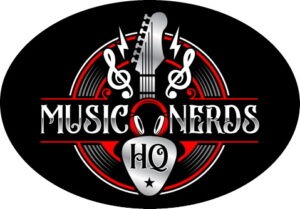Sometimes we want to play along with our favorite songs on guitar, but it doesn’t sound right: especially open chords. Or maybe we want to sing and play but in a better register for our voice. In those cases, we have to know how to transpose guitar chords.
A capo is the easiest way to shift guitar chords to a new key as it allows open chords to be played in any key. But identifying the root note of any chord progression and shifting each chord up or down in the same intervals also works for barre chords.
For example, to play F barre chords in G, all you need to do is move that position up two frets. That same F chord shape moves a whole step giving you a G chord.
Or, if we want to switch from C to G, we simply count. Start moving with the chord progression, keeping the distance of seven half steps between these keys. Remember, one half-step is equal to 1 fret on the fretboard except when moving from E to F or from B to C.
But don’t worry.
Below we’ll get into all the species, chord shapes, chord types, and the easy way to get this done without having to know a lot of music theory or anything like that.
But when is it necessary to transpose music? Does it matter if the song is a major scale or minor? And is it better to transpose guitar chords with a capo or without a capo?
Let us find out.
Table of Contents:
- How to use root notes to transpose guitar chords
- What does it mean to transpose +2 on guitar?
- How do you transpose guitar chords with barre chords?
- How do you transpose with a capo?
- What key is the capo on the 3rd fret?
- How do you know when to transpose up or down?
- Is there an app to transpose guitar chords?
- How to use alternate tunings to transpose guitar chords
- Why is it important to learn how to transpose guitar chords?
- What are the benefits of learning how to transpose guitar chords?
- How to transpose guitar chords using the circle of fifths
- Does transposing guitar chords always work?
- Conclusion
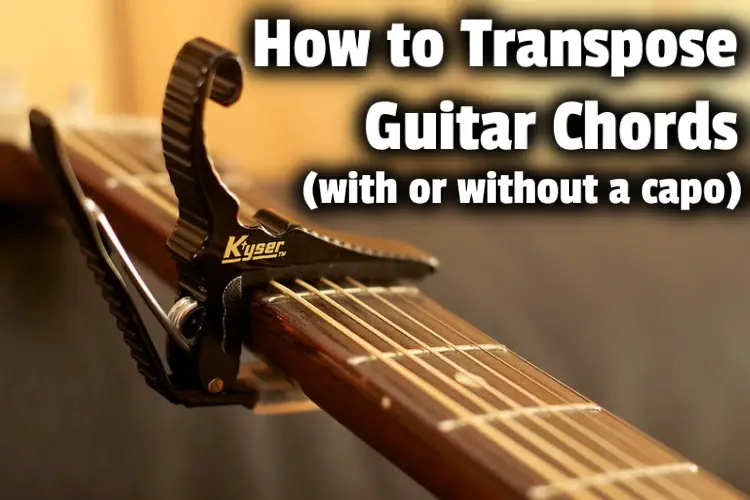
How to use root notes to transpose guitar chords
To transpose a chord using root notes, you first need to identify the root note of the chord. For example, the root note of a C major chord is C. Once you know the root note, you can find the same note on a different string or fret to create a new chord.
For example, if you want to transpose a C major chord to a D major chord, you can use the root note of C (which is on the third fret of the A string) and move it up two frets to the fifth fret of the A string, which is the note D. Then you simply play the D major chord shape using that new root note.
This technique works for all chords, including major, minor, and seventh chords.
To transpose a minor chord, simply use the root note of the minor chord instead of the major chord. For example, to transpose an A minor chord to a B minor chord, use the root note of A (on the fifth fret of the low E string) and move it up two frets to the seventh fret, which is the note B. Then you simply play the B minor chord shape using that new root note.
When using root notes to transpose chords, it’s important to pay attention to the new chord’s quality.
Moving a major chord up one fret will result in a major chord with a higher pitch, while moving a major chord down one fret will result in a major chord with a lower pitch. However, moving a major chord up or down two frets will result in a different type of chord, such as a minor chord or a seventh chord.
What does it mean to transpose +2 on guitar?
Transposing +2 on a guitar simply means moving all chords in the sequence up two frets. So, for example, F major barre chord to G major barre chord. Just make sure every chord in the progression gets moved up the same number of frets.
Let’s look at an example.
If we want to play the song “In the Air Tonight” by Phil Collins but need it to be transposed 2 steps up, it’s easy to do.
The original chords to that song are:
Dm C Bb C
I can feel it coming in the air tonight…oh lord…
Dm C Bb C
I’ve been waiting for this moment..for all my life..oh lord…
Dm C Bb C
Can you feel it coming in the air tonight..oh lord?
Dm
Oh lord…
Now if you were playing open chords you will want to use a capo to transpose +2. But it’s easy to transpose without one just by using barre chords.
Just use these chords instead:
Em D C D
I can feel it coming in the air tonight…oh lord…
Em D C D
I’ve been waiting for this moment..for all my life..oh lord…
Em D C D
Can you feel it coming in the air tonight..oh lord?
Em
Oh lord…
I try to play the Force field on the guitar. Without a capo #BuyForceFieldOniTunes pic.twitter.com/hX7u91kx1C
— Ma. Almira Coleen (@coleenC01) May 18, 2015
How do you transpose guitar chords with barre chords?
To transpose guitar chords without a capo, use barre chords, identify the root note of each chord in the chord progression and move each chord up or down the same number of intervals.
Here’s a handy chart for basic chords showing what the new chords would be transposed up:
| Original Chord | Transposed Up 1 | Transposed Up 2 | Transposed Up 3 | Transposed Up 4 |
| E | F | F# | G | G# |
| G | G# | A | A# | B |
| A | A# | B | C | C# |
| C | C# | D | D# | E |
| D | D# | E | F | F# |
The idea is to support transposing chords without a capo.
So, here it is: I also learned along the way that in music theory, there is a concept called Nashville Numbering System that a young guitar enthusiast on the internet attempted to explain briefly.
Each primary key has seven chords; for example, C has:
- C major
- D minor
- E minor
- F major
- G major
- A minor
- B diminished, or C, Dm, F, G, Am, Bdim
Now think of them as 1, 2m, 3m,4, 4, 6m, 7ldim.
Notice here that all the majors are 1, 4, and 5. Also, unless a learner plays jazz, they will never play diminished chords.
If you have a chord chart for a song in C and want to play it in G, use: 1-G, 2-Am, 3-Bm, 4-c, 5-D, 6-Em, 7-F#dim.
Assuming that you have understood the intervals of the notes I just mentioned, you will notice that you have just learned to transpose chords without a capo.
How do you transpose with a capo?
Using a capo makes it easy to transpose almost any song to any key. And whether the song is in major keys or uses a minor chord won’t matter. However, for the purposes of the chart below, I’m using major chords.
Follow this handy chart to see what the normal open chord formations become when you place the capo on different frets.
| Open Chord Form | Capo at 1st Fret | Capo at 2nd Fret | Capo at 3rd Fret | Capo at 4th Fret | Capo at 5th Fret | Capo at 6th Fret | Capo at 7th Fret | Capo at 8th Fret |
| Emaj | Fmaj | F#maj | Gmaj | Abmaj | Amaj | Bbmaj | Bmaj | Cmaj |
| Gmaj | Abmaj | Amaj | Bbmaj | Bmaj | Cmaj | C#maj | Dmaj | Ebmaj |
| Amaj | Bbmaj | Bmaj | Cmaj | C#maj | Dmaj | Ebmaj | Emaj | Fmaj |
| Cmaj | C#maj | Dmaj | Ebmaj | Emaj | Fmaj | F#maj | Gmaj | Abmaj |
| Dmaj | Ebmaj | Emaj | Fmaj | F#maj | Gmaj | Abmaj | Amaj | Bbmaj |
What key is the capo on the 3rd fret?
A capo on the 3rd fret means that your 6th open string is now a G instead of an E. If you play the E major shape with a capo on the 3rd fret, it would be a G major.
Let me explain it like this, think of your capo as the index finger of a bar shape.
Do you know barre chords? Have a look at the F major shape.
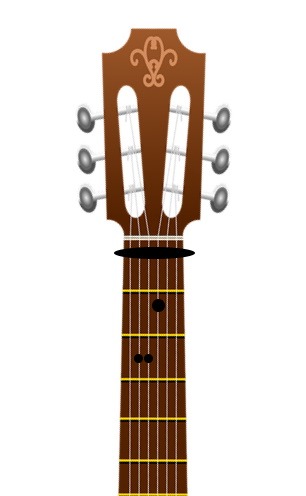
And now look at the same shape at fret 3rd, a G major.
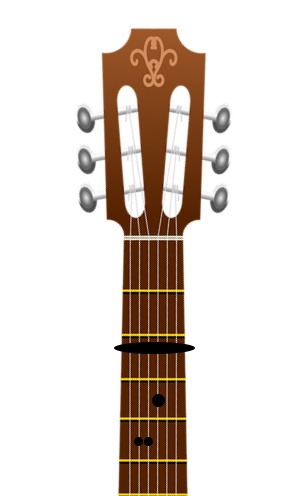
So, if you have that same shape at the first fret, it is an F major, and at the 3rd fret, it is a G major. The big black bar is your index finger that does full bar chords.
Instead of using your fingers, you can use a capo on the 3rd fret in place of your index finger.
And, then only have remaining frets that are the same as an E major. And that same chord shape could be moved down to the 2nd fret or up to the 4th fret or anywhere else you need it.
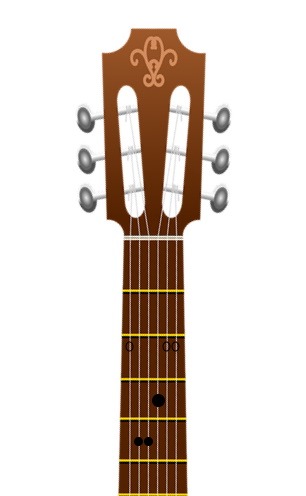
And where you see the “0” marked on the diagram above, those notes are pushed by the capo.
Technically, it pushes across the entire fretboard, but since those 3 are open strings, those are the only 3 notes you will hear directly from the capo.
How do you know when to transpose up or down?
If a song’s vocals are too high to sing, transpose the song down to an appropriate key. Alternately, if the vocals are too low to sing, transpose the song up appropriately. But certain instruments such as clarinet are tuned to B♭, so transposing 6 steps down is ideal in those cases.
But if you’re using a capo, you can’t transpose down, and you won’t want to tune the guitar strings that low. So, in that case, you’ll want to place the capo on the 6th fret to make the root note of the e strings a B♭.
But in most cases, you’ll be transposing to better accommodate a singer whose register is different from the original singer of the song you want to play.
For example, if I wanted to play a Maroon 5 song, there’s no way I can hit the high notes that Adam Levine hits. So on any of their songs, I’d have to transpose way down. (but trust me; you don’t really want to hear me try and sing like Adam).
Sometimes, transposing keys up and down on guitar can be difficult for young learners.
And this is also one of the reasons why many start learning bass first instead of guitar because it helps them get a basic understanding of the keys, notes, and chords.
But is bass really easier than guitar?
Take a look at my recent article where I have shared my knowledge about whether the bass is easier to learn than guitar. I play both and definitely have an opinion!
Just click that link to read it on my site.
That’s just way cool! I have played guitar everyday this year. I use the GuitarTapp app. It has lyrics, chords, and the ability to transpose. Setlists are a cool feature as well. Enjoy your playing! pic.twitter.com/ivPEiorpjs
— FrippDawg (@FrippDawg) July 16, 2020
Is there an app to transpose guitar chords?
Several apps like Chord Transposer Helper are available to assist guitar players in quickly transposing guitar chords. You can do that by simply entering the guitar chords of the songs and it tells you the new chords.
The app takes the mystery out of transposing for guitar players.
Learners can quickly get help transposing the chords using the in-built features. These apps are designed based on highly interactive user interfaces to record the notes carefully and scan them.
With simple clicks, they transpose the original key into desired chord progressions. To achieve the chords, you can increase or decrease chords a half or a whole tone.
Here are the five apps to help you transpose guitar chords (not paid endorsements):
| App Name | Available on | Reviews |
| Chord Transposer Helper | Apple Store | 5⭐rating |
| Guitar Capo | Apple Store | 4.5⭐rating |
| Chord Trans | Apple Store (paid, for iPad) | 4.3⭐rating |
| Guitar Chord Transposer Simple | Apple Store, Google Play Store | 4+⭐ rating |
| Chord Transposer | Google Play Store | 4⭐ |
Just click those links to go right to Apple or Google Play Store respectively.
How to use alternate tunings to transpose guitar chords
The first step is to choose an alternate tuning that suits the song you want to play.
There are many alternate tunings to choose from, such as open G, DADGAD, and drop D. Each tuning has its own unique sound and can be used to create different chord voicings.
Once you have chosen an alternate tuning, you need to figure out the new chord shapes for the key you want to transpose to.
This can be done by using a chord chart or by experimenting with different fingerings until you find the right sound. For example, if you want to transpose a song from the key of C to the key of D using the open G tuning, you would need to find the new chord shapes for D, G, A, Bm, Em, and F#dim.
One advantage of using alternate tunings to transpose chords is that it can create interesting and unexpected chord voicings. For example, using the DADGAD tuning to play a G chord will result in a different sound than using standard tuning. This can be useful for creating unique arrangements of familiar songs.
Another advantage of using alternate tunings is that it can make it easier to play complex chord progressions.
For example, the DADGAD tuning can be used to play complex jazz chords that would be difficult to play in standard tuning. This can be useful for jazz and blues guitarists who want to experiment with different chord voicings.
Why is it important to learn how to transpose guitar chords?
Transposing guitar chords is the process of changing the key of a song by moving the chord shapes up or down the fretboard.
It is an essential skill for any guitarist, as it allows you to play songs in different keys and adapt them to different vocal ranges or instrumental arrangements. In this article, we’ll explore why it is important to learn how to transpose guitar chords.
One reason why it is important to learn how to transpose guitar chords is that it allows you to play songs that may not be in your preferred key or range. For example, if a song is written in the key of E but is too high for your vocal range, you can transpose it down to a lower key, such as D or C, to make it easier to sing.
This can also be useful if you are playing with other musicians who are playing in a different key, and you need to adjust your chord shapes accordingly.
Another reason why it is important to learn how to transpose guitar chords is that it can help you develop your ear and your understanding of music theory. When you transpose a song, you are essentially analyzing its chord progression and identifying the relationships between the chords. This can help you recognize common chord progressions and understand how different chords function within a key.
This knowledge can then be applied to your own songwriting or improvisation.
Transposing guitar chords can also be useful for creating new arrangements of familiar songs. By changing the key of a song, you can create different moods or emphasize different parts of the melody or harmony. This can be especially useful for cover bands or solo performers who want to put their own spin on popular songs.
Transposing, as I mentioned in my previous post is a specific skill set guitar players should have with them. Defined as changing the musical key of a song from one key to another key. #transpose #singer #songwriter #composer #musician #guitarplayer #arrangement pic.twitter.com/t9vafYZ3Hx
— Gene Salati (@genesalati) March 26, 2020
What are the benefits of learning how to transpose guitar chords?
Learning how to transpose guitar chords is an important skill for any guitarist, whether you’re a beginner or an experienced player. Below, I’ll explore some of the benefits of learning how to transpose guitar chords.
Play Songs in Different Keys
One of the most significant benefits of learning how to transpose guitar chords is that it allows you to play songs in different keys. If a song is too high or too low for your vocal range, transposing it to a different key can make it easier to sing. This is especially useful if you’re playing with other musicians who may be playing in a different key.
Create New Arrangements
Transposing guitar chords can also help you create new arrangements of songs. By changing the key, you can create different moods or emphasize different parts of the melody or harmony. This is particularly useful if you’re a solo performer or part of a cover band and want to put your own spin on a popular song.
Develop Your Ear and Music Theory Knowledge
Transposing guitar chords can also help you develop your ear and music theory knowledge.
When you transpose a song, you’re essentially analyzing its chord progression and identifying the relationships between the chords. This can help you recognize common chord progressions and understand how different chords function within a key. This knowledge can then be applied to your own songwriting or improvisation.
Adapt to Different Instruments
Transposing guitar chords can also help you adapt to different instruments.
For example, if you’re playing with a piano player who is playing in a different key, you can transpose your guitar chords to match the piano’s key. This can also be useful if you’re playing with a capo and need to adjust the key of the chords accordingly.
How to transpose guitar chords using the circle of fifths
The circle of fifths is a musical tool that can be used to help you transpose guitar chords.
It’s a circular diagram that shows the relationship between the twelve different pitches in Western music. Each pitch is a fifth above the previous pitch, and the circle starts with C and ends with B. In this article, we’ll explore how to use the circle of fifths to transpose guitar chords.
Step 1: Identify the Key of the Song
The first step in transposing guitar chords using the circle of fifths is to identify the key of the song. This is usually indicated by the key signature at the beginning of the song or by the first and last chords of the song. For example, if the song starts and ends with a C chord, it’s likely in the key of C major.
Step 2: Locate the Key on the Circle of Fifths
Once you’ve identified the key of the song, you need to locate it on the circle of fifths. The key of C major is located at the top of the circle, with no sharps or flats in the key signature. Each subsequent key is a fifth higher than the previous key as you move clockwise around the circle.
Step 3: Determine the Chord Progression
The next step is to determine the chord progression of the song. Write down the chords in the order that they appear in the song. For example, if the song is in the key of C major and the chord progression is C – G – Am – F, write down those chords in that order.
Step 4: Identify the New Key
Once you’ve written down the chord progression, you need to identify the new key that you want to transpose the song to. For example, if you want to transpose the song to the key of G major, locate G on the circle of fifths and determine the key signature for G major (one sharp).
Step 5: Transpose the Chords
Finally, you can transpose the chords by moving each chord in the chord progression a certain number of steps clockwise around the circle of fifths.
In this case, you’re transposing from C major to G major, which is one step clockwise on the circle. To transpose the chords, simply move each chord in the progression one step clockwise. So, C becomes G, G becomes D, Am becomes Em, and F becomes C. The new chord progression is G – D – Em – C.
Using the circle of fifths to transpose guitar chords can be a helpful tool for any musician.
With practice, you’ll be able to quickly and easily transpose songs to different keys, which can help you expand your musical repertoire and play with other musicians more easily.
Does transposing guitar chords always work?
Transposing guitar chords is a useful skill that allows guitar players to play songs in different keys. While transposing can often work, it doesn’t always produce the desired result.
The main factor that determines the success of transposing guitar chords is the complexity of the song. Simple songs that only use basic chords like C, G, and D are usually easy to transpose, while more complex songs that use more intricate chord progressions can be much harder to transpose.
Another factor that can affect the success of transposing is the original key of the song. Some keys are more difficult to transpose than others, and attempting to transpose a song from one of these keys can result in chords that don’t sound quite right.
Additionally, some guitar players may find that certain transpositions don’t suit their playing style or vocal range. For example, transposing a song up several keys may make it difficult for a singer to hit the high notes.
Overall, while transposing can be a useful tool for guitar players, it’s important to approach it with caution and consider the complexity of the song, the original key, and other factors that may affect the success of the transposition. In some cases, it may be more effective to use a capo or find alternative chord voicings to achieve the desired key or sound.
Conclusion
In a nutshell, you’ll need to transpose guitar chords at some point.
And this is where the player needs to understand the entire progression or chord sequences, how to move between different keys, and keeping the same interval structure.
Transposing a piece of music is done for several reasons, including when you’re first starting out on acoustic guitar and mostly learning cover songs. Still, the real benefit of it is offering the players the ability to shift a chord progression into a more comfortable vocal range for vocalists.
Now, if you study how transposing is usually done. You will find that there are two ways to do it. You can do it via using a capo or without a capo.
But primarily, the function revolves around core steps, including identifying the chords in the original progression, identifying the chord root notes on the fretboard, moving the root notes unit to the desired pitch, and finally, rebuilding the chords into the new key.
And that’s how you can transpose the guitar chords. Happy Playing
Image by aalmeidah from Pixabay
Another image which requires attribution:
Open in G by Alan Levine is licensed under CC2.0 and may have been cropped, edited, and had a text overlay added.
